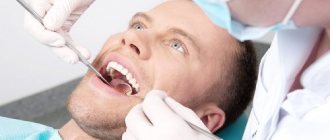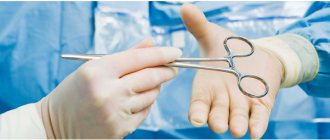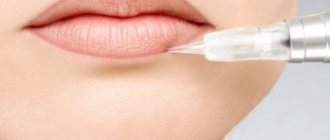As a rule, having given birth to a baby, a new parent feels incredible relief on the one hand, but on the other hand, she almost immediately becomes immersed in new worries associated with the newborn, and quite often forgets about herself. It’s good if the birth took place without complications, and the young mother can immediately begin her duties. It is much more difficult for those whose health after an important event requires long-term treatment and recovery. So, after a caesarean section, a woman will face a lot of hassle related to caring for the sutures, and it will take a lot of time to recover after the operation. Having already arrived home from the maternity hospital, the parent is faced with many questions that she did not have time to get answers to, being under the constant supervision of specialists. Among the important and popular ones: when do threads dissolve after childbirth?
In fact, every second woman has to be stitched up after childbirth, and we are not talking about a caesarean section at all. Very often, during labor, ruptures or cuts of the perineum, vagina or cervix of varying degrees of severity occur. It is clear that after childbirth it is necessary to return everything to its place, and it is necessary to apply stitches to connect the torn tissues. How this happens (under general anesthesia or local), what kind of suture the doctor will make will depend on many factors (as well as the choice of suture material for this procedure). Recently, fortunately, self-absorbable threads are almost always used, which do not require removal but disappear on their own.
Classification of postoperative sutures
How quickly the sutures heal after surgery largely depends on the nature of their application and the materials used. In this regard, post-surgical procedures are usually classified as follows.
- Bloodless (the edges of the wound are glued together with a special plaster) and bloody (a classic suture that is applied manually with a medical instrument). In turn, the latter are divided into:
- simple knots (applied at a distance of 1–2 cm from each other, after which the knot is tightened until the edges of the incision touch);
- intradermal continuous (considered the most effective, since after their healing there are no traces left);
- mattress (applied after abdominal surgery);
- purse string (used in plastic surgery, as well as in operations to reduce the volume of the stomach);
- entwining (circular sutures that are used to sew together blood vessels and hollow organs).
- Manual (applied with a needle, thread and other special tools) and mechanical (performed with a medical stapler).
- Submersible (applied during operations on internal organs with threads that are absorbable or implanted into living tissue) and removable (they are used to stitch the skin, and after the edges of the wound have fused, the threads are removed).
Absorbable sutures are made in cases where long-term fixation of the edges of the incision is required, for example, when cutting the uterus during a cesarean section. As a rule, they are performed with threads from purified connective tissue, which is subsequently rejected into the organ cavity. To apply removable sutures, threads and other fasteners made of cotton, silk, metal and other non-absorbable materials are used (more than 30 varieties in total).
Hand stitching tools
What thread are used to stitch the stitches?
Now there are quite a few types of threads that surgeons use; they can be classified both by brand and by characteristics. There are these types of threads:
- Absorbable. Able to be independently excreted from the body, incapable of rejection. These types of threads are used if the tissue is able to grow together quickly.
- Non-absorbable. Used for stitching tissues of internal organs or if long-term (permanent) stitching of tissues is necessary.
Absorbable threads are created from materials such as:
- nylon;
- polypropylene;
- catgut;
- lavsan.
When using this type of thread, it is necessary to accurately determine the rate of tissue fusion, since if the thread is removed from the body earlier than necessary, this can cause a number of problems.
Non-absorbable threads consist of the following materials:
- cotton;
- linen;
- silk.
This type of thread has a number of disadvantages. The most important thing is the ability to form microbes in tissue. When choosing, the doctor is guided not only by the purpose of the thread, but also by his own experience, and the patient’s preferences are not taken into account.
How to care for the suture after surgery?
Once the edges of the incision tighten, there will be no need for additional support. Removal of sutures in the head, face and neck area occurs already on the 5th day after the operation. If they were applied in the area of the torso or limbs, then it will take at least 10 days for the wound to heal. Daily dressings are necessary for the first few days. The patient usually spends this time in the hospital. After discharge, tight bandages are usually no longer needed. But if necessary, you can always change the dressing at the nearest hospital or medical center.
Caring for the suture after surgery consists of daily treating the incision area with an antiseptic and taking medications that accelerate tissue regeneration. All medications for home therapy are used strictly according to the doctor’s recommendation!
Treatment of sutures is usually carried out with ready-made pharmaceutical preparations or homemade antiseptics, such as solutions of iodine, potassium permanganate, brilliant green or hydrogen peroxide. To avoid getting a chemical burn when performing such procedures, the liquid for disinfection should be prepared only according to a prescription issued by a doctor.
To speed up regeneration processes, external agents with wound healing and antibacterial effects are used. These include balsamic liniment (better known as Vishnevsky ointment), levomekol, ichthyol ointment and many others.
Pain of varying intensity after surgery is absolutely normal. If discomfort is severe, analgesics approved by your physician may be used.
When to use absorbable sutures
This type of medical materials is used when suturing surgical wounds: such manipulations are carried out both on the surface of the skin, during cosmetic operations, and in deep layers of tissue, for example, during transplantation of internal organs.
The main function of such sutures is to maintain internal tissues in a stable condition until they grow together and begin to function without outside support.
It is advisable to use absorbable sutures in cases where the patient does not have the opportunity to return to the surgeon to remove the applied staples, clamps or sutures made of durable materials.
The most common use of absorbable sutures in gynecology is for suturing the perineum, tears in the vagina or cervix during natural childbirth. Studies have shown that during the postpartum period, the threads removed themselves within 2-4 months.
Additional recommendations for suture care after surgery
In addition to medical procedures, certain lifestyle adjustments are also necessary in the postoperative period. In particular, the following rules must be adhered to:
- Limit physical activity. Any high and medium intensity exercise (running, aerobics, etc.) during this period is strictly contraindicated.
- Avoid heavy lifting. As a rule, a person who has undergone surgery should not lift more than 2–2.5 kg. This rule is especially relevant when caring for a suture on the abdomen after surgery.
- Limit mobility in the waist area (avoid sharp and high-amplitude bends and turns of the body) after abdominal surgery.
- Carry out water procedures with great care. Before the stitches are removed, or better yet, before a scar forms, it is strongly recommended not to wet the wound.
- Avoid any pressure on the wound. When it comes to how to care for a suture after surgery, this is one of the main rules.
- In cases where surgery was performed on an arm or leg, the injured limb should be placed above the level of the heart (for example, placed on a pillow) during sleep. If the wound is above the level of the neck, then it is better to sleep with the head of the bed raised by 45° (two pillows are enough for this).
- During abdominal operations, observe bed rest until the doctor allows you to break it. To avoid bedsores and improve blood circulation, you can perform simple movements such as lifting your limbs and performing light self-massage.
- Strictly follow the diet prescribed by your doctor (especially after abdominal surgery).
- Protect the wound from exposure to direct sunlight. After the tissue has healed and until a full-fledged skin forms in this area, you can use sunscreen.
Factors influencing the healing process
The speed of healing of sutures depends on many factors, which can be divided into several groups:
Features and nature of the wound. Definitely, wound healing after minor surgery will be faster than after laparotomy. The process of tissue restoration is lengthened in the case of suturing a wound after an injury, when there has been contamination, penetration of foreign bodies, and crushing of tissue. Location of the wound. Healing occurs best in areas with good blood supply, with a thin layer of subcutaneous fat. Factors determined by the nature and quality of surgical care provided. In this case, the features of the incision, the quality of intraoperative hemostasis (stopping bleeding), the type of suture materials used, the choice of suturing method, compliance with aseptic rules, and much more are important. Factors related to the patient’s age, weight, and health status. Tissue repair is faster at a young age and in people with normal body weight. Chronic diseases, in particular diabetes mellitus and other endocrine disorders, oncopathology, and vascular diseases, prolong the healing process and can provoke the development of complications. At risk are patients with foci of chronic infection, with reduced immunity, smokers, and HIV-infected people. Reasons related to caring for the postoperative wound and sutures, adherence to diet and drinking regimen, physical activity of the patient in the postoperative period, compliance with the surgeon’s recommendations, and taking medications.
In what cases should you consult a doctor?
Seeking help from a doctor during the healing process of a suture is a completely normal practice, even in the absence of serious problems. And in the event of adverse reactions due to a violation of the treatment regimen or any unforeseen circumstances, it is absolutely impossible to delay it. First of all, it is dangerous to ignore the following symptoms:
- bleeding that cannot be stopped by conventional means;
- high temperature (more than 38 degrees);
- weakness, chills;
- increasing pain or other progressive discomfort that cannot be relieved with medications;
- purulent discharge of a bright yellow or green color with a thick consistency and very often with an unpleasant odor;
- severe redness, swelling, or swelling in the wound area;
- the skin at the site of injury is hard and hot to the touch;
- the appearance of a rash or blisters;
- Suspicion of seam dehiscence.
How long does it take for a wound to heal after surgery?
The rate of healing of a postoperative wound depends on many conditions. Among them:
- age;
- body mass;
- state of immunity;
- state of the cardiovascular system.
On average, it takes about 3 months from the moment of surgery to the formation of a scar. Depending on the complexity of the operation and if there are complications, this period may last 12 months. Tissue regeneration takes place in 4 stages.
- Inflammation (5–7 days). The body's standard defense reaction to damage. During this period, there is an increased production of substances that stimulate blood clotting.
- Polyferation (from 10 days to 1 month). At this stage, the formation of young connective (granulation) tissue, penetrated by a dense network of microvessels, occurs. At first it is bright red in color and grainy in consistency, but as the wound heals it becomes pale and smooth, and its bleeding decreases.
- Epithelization (from 1 to 3 months). The connective tissue is finally formed. Skin begins to form at the site of the wound. The number of vessels decreases, a scar forms.
- Scar formation (from 3 to 12 months). Temporary vessels completely disappear. Fibers of collagen and elastin - elements of connective tissue - form the scar.
Where to buy, price
Surgical suture material can be purchased at any specialty store or on websites that sell medical supplies. You do not need to provide a prescription from a doctor to purchase.
The cost of threads varies depending on the manufacturer’s brand, type of raw material, characteristics and purpose:
| Thread type | Price |
| Silk threads (braided, non-absorbable), 36 pcs. in a set of 75 cm each (qty. 25 mm). | 50 rub. per package |
| Polypropylene monofilament thread (non-absorbable material), can have a strength rating of 2/0-5/0. The length of the thread is 45 or 75 cm. | 170 rub. per package with 25 mm needles included. |
| Self-absorbing catgut, 75 cm long, without a needle. | 65 rub. per package (1 pc.) |
| Polypropylene mono, 3/0, 5/0 strength | 76 rub. per package (1 pc.) |
| Absorbable PHA threads braided (synthetic) | 85 rub. per package |
Based on the assortment, it is worth noting that threads are an affordable material. The cost is influenced by such parameters as strength index, length and quantity in the set. Despite their different origins and functional purposes, the price of synthetic and natural materials is almost the same.
How to care for a wound when the stitches are removed after surgery?
It would be useful to remind you that stitches should only be removed by a specialist - a doctor or nurse. It is strictly forbidden to perform this procedure yourself, due to the high risk of causing infection in the wound or causing bleeding.
Treatment of the incision site after removal of the sutures is carried out using the same means as before. Treatment procedures last until the wound is completely healed. This usually takes about 1 week.
Suture removal technique
Following the correct algorithm for removing sutures and maintaining sanitary conditions allows you not only to avoid infection of the wound, but also to speed up healing. Specialists explain the procedure to the patient before performing it and place him on the couch. The procedure has the following algorithm:
- Removing the protective bandage.
- Inspect the wound and determine the number of stitches to remove.
- Treating the wound with an antiseptic. It must be carried out 2 times to prevent infection, near the wound and inside.
- The suture knot is grabbed with tweezers and lifted.
- The thread that appears after pulling is cut.
- The suture is pulled back with tweezers and the knot is removed.
- Checking the integrity of the skin.
- Treating the wound with an antiseptic.
- The area is covered with a sterile napkin and then fixed with either a bandage or adhesive tape.
This procedure is performed in a hospital, but it is now quite common for postoperative sutures to be removed at home by a specialist.
Professional care for postoperative sutures at Stoletnik MC
If in any matters related to taking care of your own health, you prefer to trust professionals, you are welcome at the medical office. To help those who are not sure how to properly care for a suture after surgery, a wide range of post-operative services is available. Among them:
- dressing large and small;
- removal of stitches up to 5 cm;
- removal of sutures 5–10 cm;
- removal of stitches more than 10 cm;
- sanitation of the wound surface;
- scar excision;
- and much more.
The responsibility and high professionalism of the clinic’s staff is the key to the safe and speedy recovery of our patients. And the affordability of the services provided will eliminate the need to waste time and nerves on trips to the clinic. Sign up for procedures by phone: +7 (8412) 999-395, 76-44-20. We are waiting for you at the address: Penza, st. Chaadaeva, 95 (Shuist microdistrict).
Literature
- Belyaev A.N., Kozlov S.A., Taratykov I.B., Novikov E.I. Patient care in a surgical clinic: textbook. allowance. – Saransk: Mordovian University Publishing House, 2003. – 136 p.
- Buyanov V. M. Egiev V. N. Udotov O. A. Surgical suture. – M.: Antis, 2000. – 92 p.
- Zoltan J. Operating technique and conditions for optimal wound healing. – Budapest: Publishing House of the Academy of Sciences of Hungary, 1983. – 175 p.
- Mironova E. N. Fundamentals of physical rehabilitation. – M.: MOO “Academy of Safety and Survival”, 2016 – 310 p.
- Semenov G.M., Petrishin V.L., Kovshova M.V. Surgical suture - St. Petersburg: Peter, 2001. - 256 p.
Author: Korolev E. S.
Reviewer: reflexologist Kurus A. N.










